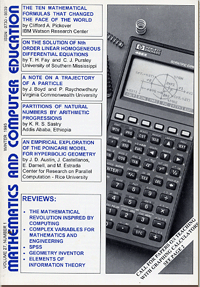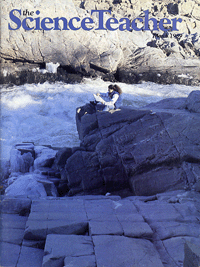
Simulation of a pen in a hole of a gear turning on the inside edge of a larger circle.
Gear Radius:
Pen hole Distance:
FPS:

|
Spirograph Javascript App Simulation of a pen in a hole of a gear turning on the inside edge of a larger circle. Gear Radius: Pen hole Distance: FPS: |

Educational Software:
|
|
Chaos Dancers
by Joel Castellanos Chaos Dancers is a type of fractal called an Iterated Function System mixed with variations and Circle Inversion. Chaos Dancers is written using a mix of Javascript, HTML5, CSS, WebGL and GLSL. |
|
|
NonEuclid:
by Joel Castellanos, Joe Austin, Ervan Darnell, and Maria Estrada Interactive Java software for creating ruler and compass constructions in both the Poincaré Disk and the Upper Half-Plane Models of Hyperbolic Geometry. The software allows students to gain experience in Hyperbolic Geometry and to empirically investigate questions such as: "In Hyperbolic Geometry, are the base angles of an isosceles triangle congruent?" The software and documentation are accessible to anyone with high school level geometry. |
|
|
Fractal Grower:
by Joel Castellanos Fractal Grower is Java software for growing Lindenmayer substitution (L-systems) fractals. In its default mode, the software displays an interface for simple L-Systems which can be modeled by paper folding. This interface is appropriate for teaching fractals to elementary and middle school students.
The full L-System interface (selectable by menu) is more appropriate for high school
and university students. |
|
|
VectorJockey:
by Joel Castellanos VectorJockey is a spaceflight simulator game designed for middle and high school physics classes. It hopes to be a fun way to gain an intuitive understanding of vector addition and Newton's Laws. Have fun and may the ma be with you! |
|
|
DFIELD & PPLANE:
by John C. Polking, David Arnold and Joel Castellanos This software is designed as a companion for 'Ordinary Differential Equations using MatLab' by David Arnold & John C. Polking. DFIELD graphs the direction field of single, first order differential equations. PPLANE graphs the direction field in the phase plane of autonomous systems. PPLANE also graphs linearizations about equilibrium points, stable and unstable orbits, nullclines, and allows the user to view solutions in three dimensions. Both DFIELD and PPLANE solve differential equations with a selection of numerical solvers, and allow the user to choose parameters of those solvers. My role in this project consisted of integrating student feedback into the early MatLab version while teaching the laboratory section of the first class in which the software was used. I then ported the MabLab version to Java. |
|
|
Polyomino: polyomino
by Luke Balaoro, Joel Castellanos and Ezra Stallings Poyomino is a simple, web-based puzzle game that plays with building higher order polyominos from lower order monominos, dominos, trominos, tetrominos (the 5 Tetris blocks), pentominos, hexominos, heptominos, and up through octominos. |
|
Joel Castellanos, Rick Kapalko, Chris Worth;
"RSC Trending Tool: System Design Analysis".
GSAW 2005 (Ground System Architectures Workshop) Conference Proceedings, March, 2005 Abstract: The U.S. Air Force Space and Missile Systems Center (SMC) at the ground systems Research, Development, Test, and Evaluation (RDT&E) Support Complex (RSC) located at Kirtland AFB, has developed an in-house Trending Tool system. The system is used for archiving, graphing, and statistical analysis of State of Health (SOH) telemetry to support anomaly resolution and long-term trend analysis. This presentation examines strategies for user navigation through the very large data space, and a general case for small group development of in-house software rather than using Commercial Off-the-Shelf (COTS) software. In particular, the SOH telemetry, as opposed to general data, exhibits distribution qualities that allow for specialized data management. Furthermore, user access patterns have been identified across multiple satellite missions that can be leveraged to significant advantage. |
|

|
Joel Castellanos, Lance R. Williams
Automatic Synthesis of Isotropic Textures on Surfaces from Sample Images University of New Mexico, TR-CS-2003-07, July 2003 Abstract: A fully automatic method of synthesizing isotropic textures on subdivision surfaces from sample images is presented. Both Gaussian and Laplacian pyramid representations of the sample texture are constructed. Texture synthesis proceeds coarse-to-fine, by incrementally inverting the Laplacian pyramid to produce an initial guess and refining this guess using non-parametric sampling. The sampling procedure uses a nearest neighbor search while preserving first-order statistics. The resulting texture is generated directly on the subdivision surface. Within the domain of isotropic textures, the proposed method offers improvements in faithful reproduction of a sample's appearance over a wide range of scales. The method can also be used to produce isotropic variants of anisotropic textures. Finally, while the sampling procedure we describe is not amenable to standard methods for nearest neighbor search in high dimensional spaces, an acceleration method is proposed that uses an eigenvector transform and a set of dynamic Kd-trees. |
 |
Leslie Miller, Joel Castellanos;
"Use of Technology for Science and Mathematics Collaborative Learning". School Science and Mathematics Journal (SSMA), February, 1996, Volume 96, Number 2. Abstract: This article represents an example of how computer software can be used to facilitate collaborative learning and the integration of mathematics and science. "Snap shots" from a pilot project, with thirty high school juniors who were involved in a university summer program, reveal how student-centered learning is facilitated by technology. This exploratory trial provides a glimpse of what the "classroom after next" might look like utilizing groupware in instructional settings. |
 |
Joe Austin, Joel Castellanos, Ervan Darnell, Maria Estrada;
"An Empirical Exploration of the Poincaré Model for Hyperbolic Geometry". Mathematics and Computer Education, Winter 1993, Volume 27, Number 1. Abstract: This paper introduces a new software tool, NonEuclid, which enables the user to easily perform ruler and compass constructions and measurements in Hyperbolic Geometry. The paper demonstrates how the software can be used to explore geometric patterns and theorems in Hyperbolic Geometry, as well as help to teach an axiomatic approach to geometry in general. A study of Hyperbolic Geometry can help students break away from long held pictorial definitions of geometric objects by offering a world in which the pictures are all changed; thereby helping students focus on the exact words in formal definitions of familiar objects such as squares, isosceles triangles, rhombuses. |
 |
Joel Castellanos;
"Thinking Through Writing". The Science Teacher, March 1989. Abstract: The paper presents an out-of-class writing method for helping students understand and internalize scientific concepts and theories. The proposed method breaks sharply form the typical writing assignments of summery reports and research papers. In particular, it focuses on careful student critiques of small segments of the given textbook, question articulation, development interconnections between class topics and concepts from other classes or life experience, student generated thought experiments, and imagination. The paper includes instructor guidelines and student hand-outs. |